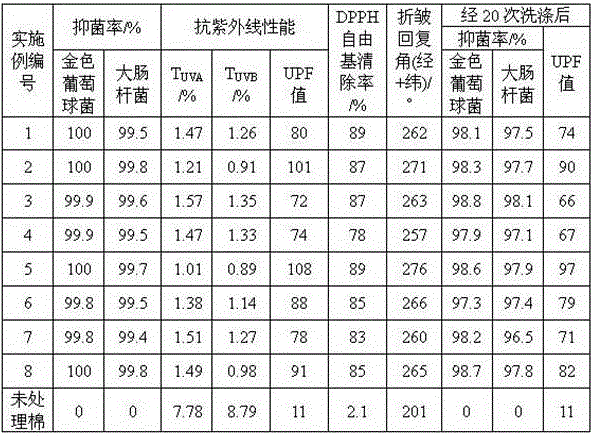Treatment method for antibacterial and anti-ultraviolet cotton fabrics
A treatment method and cotton fabric technology, applied in fiber treatment, biochemical fiber treatment, plant fiber, etc., can solve the problem of cotton fabric’s unsatisfactory anti-ultraviolet performance, improve anti-oxidation and scavenging free radical performance, improve adsorption fastness, The effect of increasing the amount of binding
- Summary
- Abstract
- Description
- Claims
- Application Information
AI Technical Summary
Problems solved by technology
Method used
Image
Examples
Embodiment 1
[0038] A natural antibacterial agent preparation:
[0039] Wash the natural plant material grape seeds, dry them, pulverize them with a pulverizer, and extract them under reflux at 70°C for 100 min at 70°C, then vacuum filter 1. Removing slag, concentrating the extract under reduced pressure, and freeze-drying the concentrate to obtain natural antibacterial agent powder.
[0040] B. Pretreatment of cotton fabric: Soak the cotton fabric with an aqueous solution of 0.5 g / L non-ionic surfactant penetrating agent JFC for 5 minutes, take it out, and dry it in the air.
[0041] C carries out chitosan quaternary ammonium salt modification treatment to cotton fabric: with the modified working solution that chitosan quaternary ammonium salt 5 g / L, zinc acetate 1.5 g / L are formed, carry out two treatments to the cotton fabric after step B treatment Soak and roll twice, the excess rate is 120%, dry at 85°C, and then bake at 120°C for 2 minutes.
[0042] D antibacterial finishing liquid...
Embodiment 2
[0050] A natural antibacterial agent preparation:
[0051] Wash the natural plant material persimmon leaves, dry them, pulverize them with a pulverizer, and extract them under reflux at 80°C for 80 minutes according to the weight ratio of the plant material persimmon leaves and 50% ethanol solution with a mass percentage ratio of 1:25, and then vacuum filter 1. Removing slag, concentrating the extract under reduced pressure, and freeze-drying the concentrate to obtain natural antibacterial agent powder.
[0052] B. Pretreatment of cotton fabrics: Soak cotton fabrics in an aqueous solution of 0.4 g / L of non-ionic surfactant Pingping plus O for 6 minutes, take them out, and dry them in the air.
[0053] C carries out chitosan quaternary ammonium salt modification treatment to cotton fabric: with the modified working solution that chitosan quaternary ammonium salt 4 g / L, zinc acetate 3 g / L are formed, carry out two treatments to the cotton fabric after step B treatment Soak and ...
Embodiment 3
[0062] A natural antibacterial agent preparation:
[0063] Wash the natural plant material Ginkgo biloba leaves, dry them in the air, pulverize them with a pulverizer, and extract them under reflux at 65°C for 120 minutes according to the weight ratio of the plant material Ginkgo biloba leaves to the mass percentage of 70% ethanol solution, and then vacuum filter 1. Removing slag, concentrating the extract under reduced pressure, and freeze-drying the concentrate to obtain natural antibacterial agent powder.
[0064] B. Pretreatment of cotton fabric: Soak the cotton fabric in an aqueous solution of 0.3 g / L of nonionic surfactant lauryl glucoside for 8 minutes, take it out, and dry it in the air.
[0065] C. Carry out chitosan quaternary ammonium salt modification treatment to cotton fabric: use the modified working liquid that chitosan quaternary ammonium salt 8g / L, zinc acetate 2 g / L forms, carry out two immersions to the cotton fabric after step B treatment Two rolling, 100...
PUM
 Login to View More
Login to View More Abstract
Description
Claims
Application Information
 Login to View More
Login to View More - R&D
- Intellectual Property
- Life Sciences
- Materials
- Tech Scout
- Unparalleled Data Quality
- Higher Quality Content
- 60% Fewer Hallucinations
Browse by: Latest US Patents, China's latest patents, Technical Efficacy Thesaurus, Application Domain, Technology Topic, Popular Technical Reports.
© 2025 PatSnap. All rights reserved.Legal|Privacy policy|Modern Slavery Act Transparency Statement|Sitemap|About US| Contact US: help@patsnap.com


